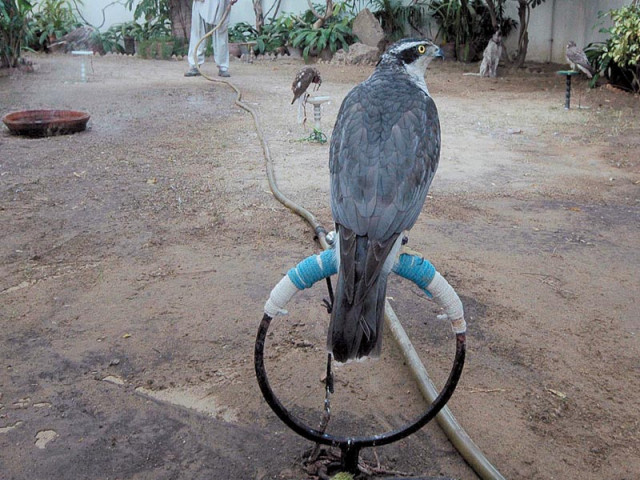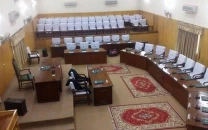Inglourious bustards
A tale of two visitors, one who comes to nest and the other who comes to kill.

Wearing dark sunglasses to cut the glare of the sun, the passengers excitedly disembark to locate what the LCD screen tells them is just overhead. They look skywards, trying to focus on the sun with eyes that are forced to squint despite the dark shades they are wearing. It almost looks like a scene from an old Ray-Ban ad. Gradually, they focus on a tiny dark spot in the sky. Is it what they are seeking, or is it just another illusion of the desert sun?
Slowly, the dark spot begins to increase in size. A screeching pierces the calm as a falcon descends upon the sand dunes. Suddenly, a portion of the sand dune seems to move! It’s the elusive Houbara bustard, well camouflaged against the sand. Intimidated by the falcon, it takes flight in a desperate attempt to flee the soaring predator. The falcon dives and curves towards its target with sharp talons now facing towards the ground like an aircraft’s landing gear.
The bustard still has one trick up its feathered sleeve. It swivels sharply to avoid death but is stalled by a sudden gust of wind. Wham! The aerodynamic falcon smashes into its prey in a flurry of claws and feathers and it’s over in the blink of an eye. With euphoric cries, the hunters, run to perform the “zabiha” of the Bustard to make it Halal. They divert the falcon from its prey with a chunk of meat kept especially for this purpose. This is the climax of a typical falconry expedition.
I first came to know of this activity on a wildlife photography trip. While planning to visit a brackish-water lake, our host told us that he would request the “wildlife guys” to drive us in their vehicle. He took us to a tent pitched right next to the highway with a few charpoys around it and wide tyre marks indicating the frequent movement of heavy 4x4 vehicles. The “wildlife guys” greeted our group and told us that all their vehicles were already on “patrol duty”. It had been reported that poachers had made a few kills and a VIP visit was also due — hence the increased vigilance. Disappointed, we proceeded to visit the lake in our old jeep.
On our way back, as we approached the same tent, our guide announced “Look! One of their trucks is back”. A brand new top-of-the-line 4x4 truck was parked next to the tent, its hood and sides partially covered with a layer of fine dust. I wondered how government wildlife institutions were able to afford such an expensive vehicle.
My suspicions were confirmed when I observed that the vehicle had a foreign number plate. When asked, our host and guide laughed. “You think these are government employees? No, sir! They are hired by Arab sheikhs who will soon be visiting the area for hunting Talaur (the local name for Houbara bustards). They fund the locals and provide vehicles to ensure that no one else hunts in the area allotted to them by the government.” Warming to the topic, he continued: “All this is carried out through the local chiefs. By law, Pakistanis are forbidden to hunt Talaur; in a way, these guys are the law-enforcers! Try shooting down a Talaur here and you will see what happens to you!” The part-infotainment-part-warning was delivered in a manner that, coupled with my host's cordial relations with the “wildlife guys”, led me to wonder if some benefits trickled down to my host, who was associated with “conservation” work himself.
In later years I came to know of other arrangements that the hunters put in place. These include heavy-duty water, fuel and oil tankers that service their encampments. They can be seen scurrying on highways in rural areas during the hunting season. Earlier, I had only seen such desert-enabled tankers during TV coverage of the Paris-Dakar rally!
The air would reek of hi-octane petroleum as an entourage passed by at high speed. The hunters would come equipped with satellite phones, GPS devices, internet connectivity, radio tracking equipment and walkie-talkies among other gadgetry. The temporary tent settlements that they had set-up looked like something straight out of Arabian Nights, complete with air-conditioned tents powered by huge generators for the senior sheikhs.
The Houbara hunts in Pakistan, over the years have been an elaborate affair, with Arab royals arriving in their private jets followed by C-130s full of vehicles, equipment and support staff. The hunts are not monitored by wildlife departments but interestingly are the domain of the ministry of foreign affairs. They have almost caused diplomatic rows when the quotas allocated to royals of various countries were deemed insufficient by them. Nowhere else in the world does the Houbara command such importance. Foreign royals have even bought huge private estates throughout Pakistan in areas where the bird sojourns.
The picture painted in the Pakistani media is that the Arabs are here to satisfy their gastronomic indulgence with the Houbara bustard that supposedly has aphrodisiac properties. The Arab version is that they value their traditions and consider their culture an indispensible ingredient of their honour. Falconry is part of their tradition and they are here not just to eat the bird but in fact to practice the traditional art. The Houbara bustard has the misfortune of being their target due to its in-flight trickery, its skill and speed on the ground and its cautious nature — all of which make it a very difficult prey.
Houbaras originally visited the Arabian Peninsula in large numbers, but over the years, as oil money financed better hunting gear and trucks replaced camels, the migrant birds could not sustain the pressure and are now on the verge of extinction. Originally inhabitants of colder climes such as Siberia, different colonies of the bird descend to warmer areas in the south. The columns descending to the Middle East have thinned to near extinction.
In Pakistan, however, the greatest threat which the Houbara faces is not from foreigners but in fact from habitat degradation and local aficionados. Whether eating the poor bird actually increases virility or not, the myth is now established among the local hunting-guides and the inhabitants of rural areas near the wilderness. Unlike the Arabs, the locals do not practice falconry, but instead use guns to shoot down the bustards. They do not follow the traditional codes followed by the Arabs and end up killing any other bird or mammal that they come across as well.
Trophy hunting is used as a tool for conservation in many parts of the world. Expensive licenses are auctioned for a limited number of animals to be hunted during a limited hunting season. The proceeds of the licenses are spent on conservation efforts, social uplift of local rural population and the creation of jobs. Trophy hunting of ibex and Markhor is reported to have resulted in increase of animal populations in some areas of Pakistan. Similarly, the Houbara hunts should be used to finance conservation and economic uplift while strengthening foreign relations. However, the petro dollars currently flow only to some government functionaries and local lords, while the general public living around the hunting grounds remains illiterate and without access to basic facilities. It is a failure of our system to distribute the benefits of hunting-tourism equally and beneficially.
Additionally, countries like the UAE, Saudi Arabia, Morocco, etc, are now realising the importance of conservation and have initiated comprehensive, and well-funded, conservation programs. Pakistan is blessed by nature with several fertile breeding grounds of the Houbara in the deserts of Balochistan and Cholistan, placing us in an ideal position to claim a share of the economic opportunities that international conservation projects create.
For now, the Houbara bustard, a foreign visitor that flies in every year during the winters to nest, has to contend with both local hunters and foreign visitors who also fly in seeking trophies. As for its alleged aphrodisiac properties, I am happy to say that I don’t have the information — or the need — to verify them!
Published in The Express Tribune, Sunday Magazine, November 24th, 2011.


















COMMENTS
Comments are moderated and generally will be posted if they are on-topic and not abusive.
For more information, please see our Comments FAQ